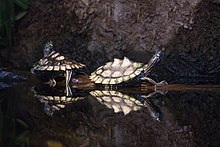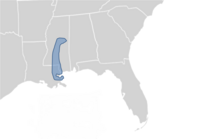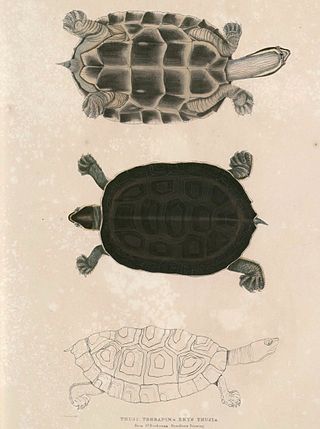
The brahminy river turtle or crowned river turtle is a species of turtle in the family Geoemydidae. The species is endemic to South Asia.

The razor-backed musk turtle is a species of turtle in the family Kinosternidae. The species is native to the southern United States. There are no subspecies that are recognized as being valid.
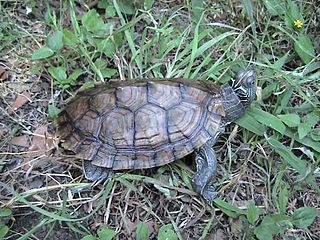
Graptemys is a genus of freshwater turtles containing 14 species, commonly known as map turtles. Graptemys are small to medium-sized turtles that are significantly sexually dimorphic, with females in some species attaining as much as twice the length and ten times the mass as males. Depending on the species, adult males range from 7–16 cm (2.75–6.25 in), adult females 10–29.5 cm (4–11.62 in), and hatchlings 2.5–3.8 cm (1–1.5 in), although some sources indicate female Barbour's map turtles grow to 33 cm (13 in) in length. Most species have a distinctive dark pigmented keel that is often notched or serrated running down the center of the carapace and serrated scutes on the rear margin. The head, neck, and limbs exhibit bold patterns of yellow lines and spots against darker green, olive, or black base colors. The patterns on the head can be important characters in identifying the various species. The common name "map turtle" is derived from the intricate patterns on their shells that are suggestive of topographical maps, although the patterns are more apparent in some species than others, and often become obscure in older specimens. Some species are occasionally called "sawbacks", in reference to the serrated keels on their shell.
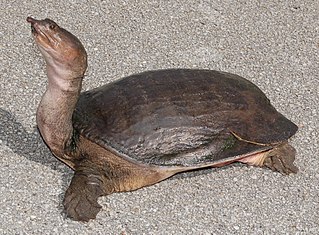
The Florida softshell turtle is a species of turtle in the family Trionychidae. The species is native to the Southeastern United States.

The Big Bend slider, also called commonly the Mexican Plateau slider and la jicotea de la meseta mexicana in Mexican Spanish, is a species of aquatic turtle in the family Emydidae. The species is native to the Southwestern United States and northern Mexico.

The Texas map turtle is a species of emydid turtle endemic to Texas.

Barbour's map turtle is a species of turtle in the family Emydidae. The species is native to the southeastern United States.
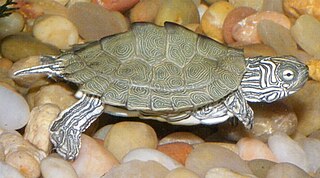
Cagle's map turtle is a species of turtle in the family Emydidae. The species is endemic to Texas, where it is native to the Guadalupe, San Antonio, and San Marcos Rivers.

The Escambia map turtle, also known commonly as Ernst's map turtle, is a species of turtle in the family Emydidae. The species is endemic to the United States.

The yellow-blotched map turtle, or yellow-blotched sawback, is a species of turtle in the family Emydidae. It is part of the narrow-headed group of map turtles, and is endemic to the southern United States.
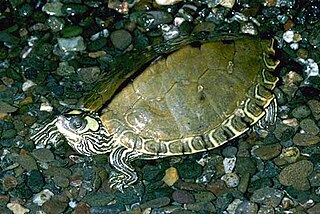
The Pascagoula map turtle is a species of turtle in the family Emydidae. The species is native to the southern United States.

The black-knobbed map turtle, formerly known as the black-knobbed sawback, is a small to medium-sized aquatic turtle with light gray skin. Some of the most distinguishing characteristics of the black-knobbed map turtle, and the Graptemys genus, are the protruding "spikes" on the turtle's carapace. This species inhabits mainly the fall lines of rivers in the Mobile Bay drainage, in Alabama and Mississippi.
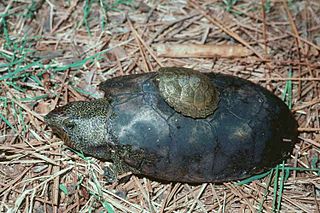
The flattened musk turtle is a critically endangered species of freshwater turtle in the family Kinosternidae. The species is endemic to the southern United States.

The northern map turtle, also known as the common map turtle, is an aquatic turtle in the family Emydidae. It is endemic to North America.

The Mississippi map turtle is a subspecies of land and water turtle belonging to the family Emydidae. G. p. kohni is endemic to the central United States.

The false map turtle is a species of turtle endemic to the United States. It is a common pet species. Two subspecies are recognized, including the nominotypical subspecies described here.

The striped mud turtle is a species of turtle in the family Kinosternidae. The species is native to the southeastern United States.
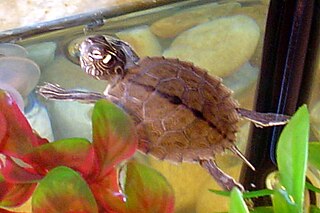
The Ouachita map turtle is a species of turtle belonging to the family Emydidae.
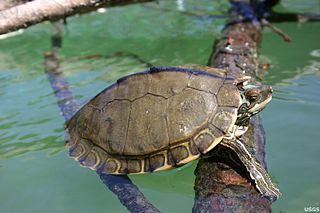
The Pearl River map turtle is a species of emydid turtle native to the southern United States. According to a study done in January 2017, the species G. pearlensis was significantly less abundant in the Pearl River region as compared to G. oculifera and exhibited a smaller number of reproductively mature females. Further, this study highlighted statistical and observational evidence that this species exhibited female-biased, sexual dimorphism.
